#lubber fiend
Explore tagged Tumblr posts
Text

House Spirit (Early Modern)
House spirits are a group of beings united by behavior rather than genealogy. While there are some supernatural creatures which will perform domestic duties for an incentive, house spirits are intrinsically tied to the property they live on or in. One could say that they are symbiotic with humans, but the truth is not so simple. House spirits are anything but servile. In their minds, the house they live in is theirs. The humans inhabiting it are merely tenants which they have to pick up after. Violations of the spirit's rules lead to an eviction, so to speak, where the spirit tries to force them out. Unlike mundane landlords, a house spirit is important to a home's health. They keep the house from aging, holding it together in a very real sense. Many inhabit farmsteads where the prosperity of the crops and animals is in no small part due to the house spirit's presence. As the farmers toil during the day, the spirit will do their own labor, vastly improving the health and conditions of the animals and plants. There are many varieties of house spirits. Specifics, like forms of appeasement, behavior, appearance, etc., depend on the species. Regardless of what breed you encounter, remember to show respect.
-Habitat: Coterminous with human settlements, especially farmsteads.
-Slayer Tips: Spread a fine material capable of catching invisible footprints, like flour or sugar. Just make sure not to leave it out for too long, or else the spirit will clean it all up.
--
The first urban creatures of the bestiary! The brownie and nisse are based on less conventional descriptions; the brownie has no nose and a brown mantle (where the name "brownie" comes from), and the nisse has a single eye. The domovoy is based on a famous painting by Ivan Bilibin. The kobold is based on their supposed origin as the ghost of a child and their infrequent appearance as a pillar of flame. Finally, the portune and lubber fiend are here to demonstrate the size variation. Respectively they're the smallest and largest of the house spirits.
11 notes
·
View notes
Text

Household Fae
RARITY: ★★☆☆☆ | THREAT: ★★☆☆☆
HABITAT:
Almost exclusively in the homes of people. They can’t survive out in the world on their own.
OVERVIEW:
Many fae species have found a parasitic lifestyle suits them. Some may find shelter in human homes for safety or easy sources of food, while others may have more specific needs that can only be met by cohabitation. It’s common for these fae to ransack the kitchens and cupboards at night in search of food, and others may cause additional havoc around the house, such as throwing things around, pulling pranks, and inviting some more dangerous friends over. Most can use some magic to cause further chaos. Household fae aren’t capable of human speech, but many have at least somewhat of a grasp of human language enough to understand what is being said to them. These fae are all weak to iron, and many are vulnerable to charms that can be placed around the home to keep them out.
In many cases, it’s possible to win the favor of these fae through kindness and offerings of food. Should that happen, they will be less likely to cause trouble… provided your kindness continues. Some will accept certain gifts or deals in exchange for leaving a home for good. While most household fae lack physical defenses, they tend to be quick-moving and skilled at evading attempts to squash them. Culling these common pests can be the bread and butter for some wardens who are content for an easier hunting life.
TYPES
BOGGART:
The size of a mere guinea pig, boggarts can cause a lot of chaos despite their stature. Rarely seen but always present, they can cause milk to sour, things to vanish, and animals to startle; they take pleasure in this but don’t mean to cause harm. It’s rare that those cohabitating with a boggart actually see what it looks like. Those who do get a glimpse will see a small, rabbit-like creature that makes tell-tale scratching noises as it traverses the house with incredible speed. They can hide in even paper-thin crevices that defy physics. Boggarts have been known to be a little more cooperative with people they’re fond of, but that’s not saying much. They’re difficult to capture due to their speed and ability to hide, and will manage to find their way back if relocated; killing them is usually the only way to permanently rid yourself of one. They have a fondness of peanut butter, both smooth and crunchy.
BROWNIE (HOB, DOMOVOI):
Easily confused with the dessert in casual conversation by laypeople, brownies are unpleasant little house guests. Going by different names in different cultures, this species has a worldwide distribution. They stand about 2 feet tall and have very sharp teeth. These tricksters enjoy the typical mischief, but also have proclivity toward stealing and collecting things. Owners may stumble upon a cache of socks or jewelry in the home. When approached, they behave like a wild animal and will attack with claws and teeth before turning invisible to escape. They release a pungent odor when frightened that smells like rotting cheese. Some brownies will accept food offerings in exchange for chores, but others may take offense and become more troublesome. Brownies are fiercely territorial, so introducing the scent of another brownie will draw them out.
BULLYWUG:
These amphibious fae are known to lurk around the pipes of kitchen sinks. While frog-like in appearance with brown, green, or dull yellow skin, they are seen walking on two legs more than they are hopping on all four. Bullywugs particularly love the bits of food left behind on dishes and are especially attracted to homes where dishes sit in the sink for long stretches of time. While mostly harmless, bullywugs cause chaos in the kitchen. From adding extra sugar to recipes to hiding kitchen utensils, bullywugs will do just about anything to confuse humans. Usually, it’s all in good fun, but bullywugs can get aggravated if the humans in “their” home start cleaning up food too quickly. For little frog-like creatures, they have surprisingly sharp teeth and have a tendency to bite people’s hands while they’re doing dishes. Keeping a cleaner kitchen will eventually cause bullywugs to move. There are some less savory methods for removal involving food and garbage disposals as well, but it is rumored killing them is bad luck.
FENODYREE:
These hair-covered, little kitten-sized fae are proven annoyances. They take up residence in peoples’ houses, specifically underneath the stairs. They’re known to grab the ankles of people going up and down if displeased, and might chomp off a toe or two with their sharp teeth if successful. Another hallmark of a fenodyree is using their power to freeze people in place so they’re stuck where they stand. If a fenodyree is so inclined, and has some food left out for them every night, they may decide to help with household chores and will assist in guarding the homestead from intruders. However, they’re much more likely to cause trouble. Because fenodyree are known to feed on human flesh, they are less sensitive to heme iron than most other fae species, but are still vulnerable to iron blades. Additionally, they’re terrified of wearing any clothes. If someone can force a piece of clothing onto a fenodyree, they’ll leave their dwelling forever.
LUBBER FIEND (LUBBERKIN):
Standing at about 3 feet tall, lubber fiends are the largest of the common household fae, though they’re typically seen on all fours. They have a lanky, goblin-like appearance and exclusively reside in homes that have wine cellars, where they gorge themselves on the finest wine. They also scrounge through peoples’ kitchens when they’re not paying attention, and when not living in a home, can occasionally be seen digging through garbage cans and dumpsters. While lubber fiends aren’t violent by nature, their presence is dangerous. Those sharing a home with them will slowly be driven closer toward temptations like drunkenness, gluttony, and lasciviousness; this can result in regretful actions and risky behavior that may be deadly. Once the lubber fiend is evicted, these behaviors come to an end. If the lubber fiend can’t be killed, it can be lured out with its favorite meal (though figuring out what this is may take some time).
#household fae#monsters#supernatural rp#town rp#original rp#fae rp#new rp#lubber fiend#lubberkin#fenodyree#bullywug#brownie#hob#domovoi#boggart
2 notes
·
View notes
Text
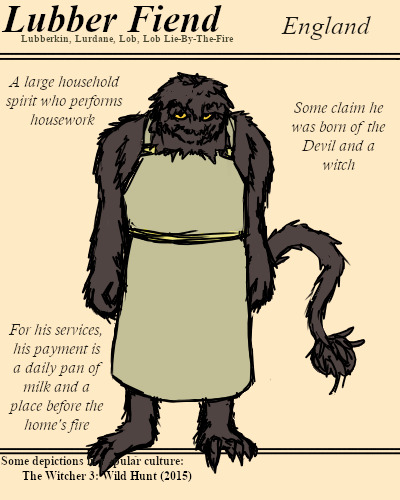
A large and hairy household spirit, a lubber fiend is a hard worker for as long as his payment is maintained.
#BriefBestiary#bestiary#digital art#fantasy#folklore#legend#myth#mythology#lubber fiend#lubberkin#lurdane#lob#lob lie-by-the-fire#fae#fairy#faerie#household spirit#english folklore#english legend
20 notes
·
View notes
Text

Portrayal Of Guilt
The Lubber Fiend, Newcastle, England. 14/12/23.
2 notes
·
View notes
Text
5 notes
·
View notes
Text
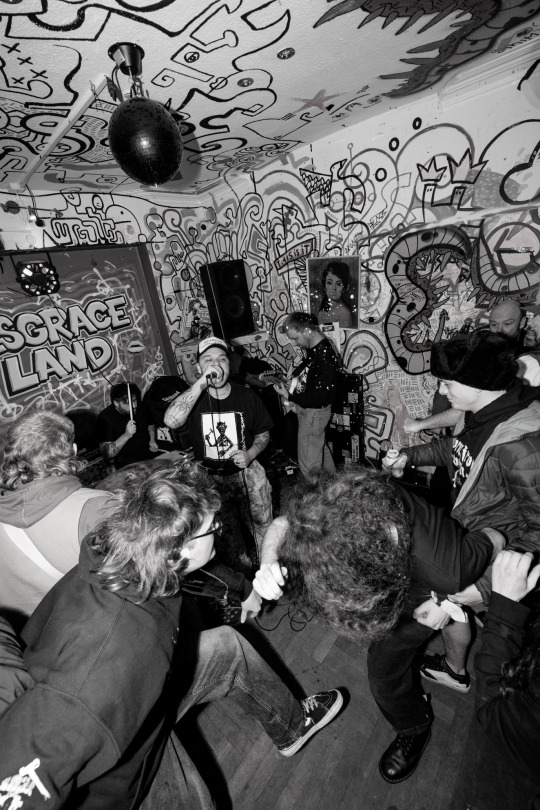
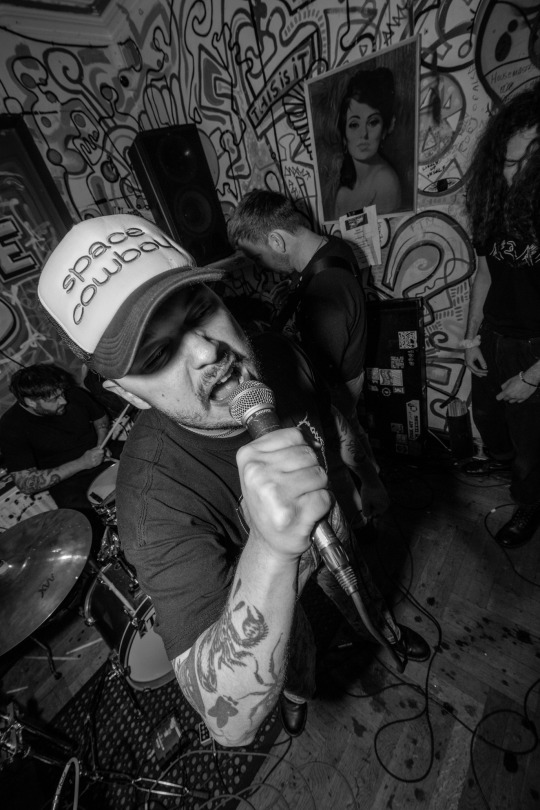
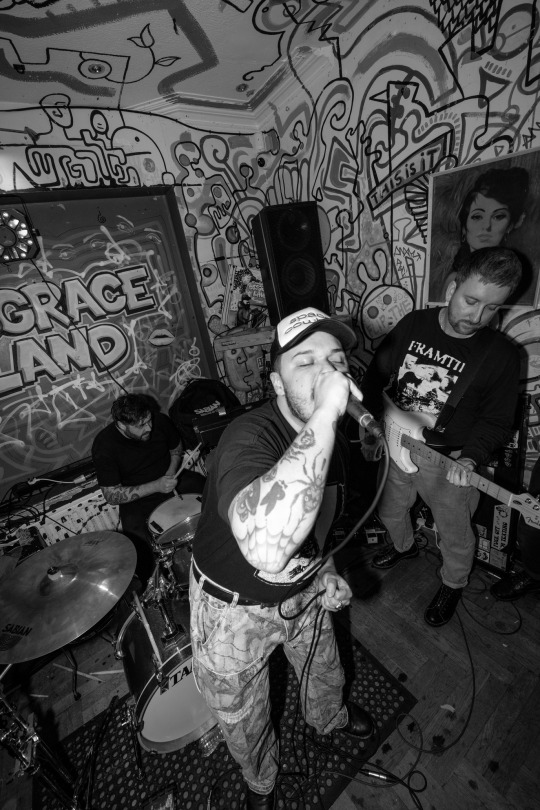
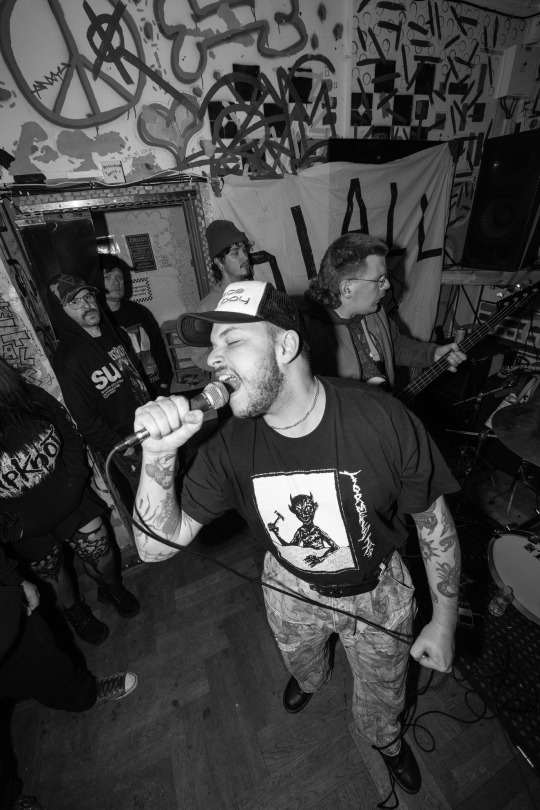
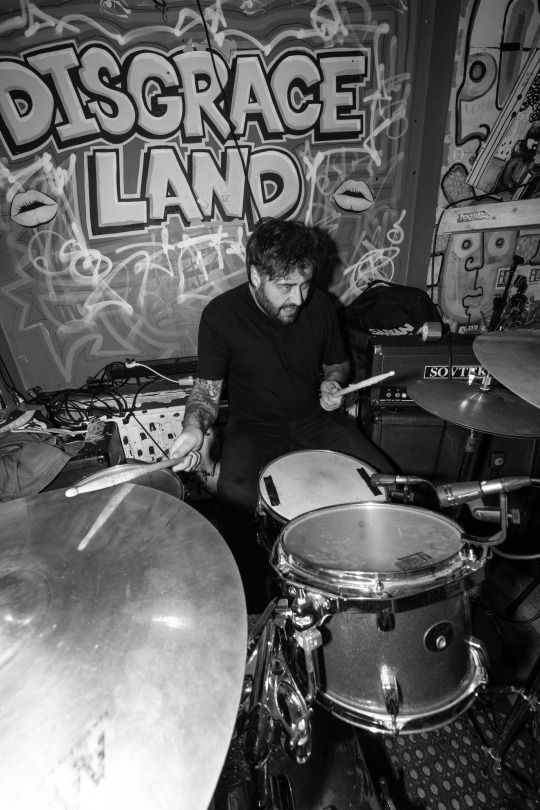


Photos from Disgraceland, Middlesborough by Tom White The scene in Boro is popping, thanks to Death Biter Recs for having us.
Rory is now permanently on bass.
Tomorrow night we’re at Lubber Fiend w. Seer, Video Evidence & Burial Plot. Come thru!
0 notes
Text
Fuji Joe live @ The Lubber Fiend.
.
Gem
0 notes
Note
ok this is an example of the butterfly effect
bc of the comment that atzurae would have a cloesona, i immediately thought of them and kofruth in this. fucking meme

and the thought + audio of this made me giggle so much it distracted me off of drawing and i went out to run off to some music and proceeded to find a massive lubber grasshopper outside drinking water. thank you for helping me discover this fiend

Might be a weird question, but you know how humans tend to anthropomorphize animals and objects and such like in fiction?
Either by just giving them human language and thoughts, or by also making the animals/objects stand on two legs or an upright pose and more human like anatomy in the case with furries and such?
Or even give themselves features of animals like my sona with deer ears and legs and a long tail and such?
Or in ancient Egypt with the depictions of gods with animal heads
Or heck even just furries and fursonas
On Bolur, in any era, do the homo mousike ever anthropomorphize animals or objects in their art and stories? How would a Debu/Zebraman/elf fursona look like? How would they visually anthropomorphize other things in their art and stories?
I think about these things sometimes (when it comes to alien life/spec biology in general)
OOOOH. I LIKE THIS QUESTION A LOT.
So first: Yes, they anthropomorphize their animals and objects! Definitely now when their collective histories just began, but especially so in Zebraman culture all throughout their history, when their entire lives are centered around their animals (recent update, I need to flesh it out). Just about every zebraman god is animal-based because of it, and zebramen have way more societies focused on stewarding the land and its animals.
Debu anthropomorphize objects slightly more than other homo mousike - when nothing around you is your size, you relate to the things that are, and generally those things were the things made for you. They give them faces and have these masks or collective objects dedicated to concepts or people, or a particular figure is embued with a spirit of their own.
As for fursonas...
Ok, here on out, I'm gonna be calling them pycnofiberies, since everything here will be based on the night cloe. This is the debu Dog so I think this is a good candidate for furry-ization, and just for simplicity I'll use the night cloe for the zebrapeople anthros, too.

So, first thing off the bat - the most obvious anthromorphization for debu is sizing everything to their just like we do, it's just more obvious now that they're huge. The front teeth are usually really bunched together and seperate from the others on Bolur and while fusing together into beaks or tusks is common, the teeth are often seperate, like they are in night cloes. Debu often fuse them together to make them resemble tusks more ( since gaps in teeth are kind of uncanny to them) and add a beard, even if it's just stubble to their anthros, the same way we add our hair. They also add a mouthglow! In cartoons, Debu mouthglows sometimes are neon colored rather than just white as an exaggeration of the minute color differences in actual mouthglows, either to tell apart individual debu, as stylization or to be more obvious to the yellow-blue colorblind zebrapeople. (which is why yellow and green dyes are so rare - the species that develops the most dyes don't percieve greens and yellows very well.)
Also, a hump, in the same way we add boobs to everything regardless of the boobage in the actual animal. Humps in debu are attractive in both sexes, and are usually added regardless of the intent on making a character attractive.
And of course, for expressions, the nostrils are exaggeratedly large, no matter what animal it's on.

There's also the exaggeration of facial discs in night cloes the same way ears are in our furries, sometimes so extreme the edges jut out from the face. There's also a feature in a lot of "mary sues"/"gary stus" where the claws are overgrown - in Debu cultures, gods are often depicted with overgrown, curved hooves to demonstrate their age and "mythical-ness", as it's an occurrence in elderly debu but not a very common one. So, to show power, alongside a brightly glowing mouth, mary sue cloesonas have great, curved claws. There's also the "beastars" style hands, where they'll give their hooved hands to animals with little other animalistic detail.

Then there's cloe-girls and "angels"
Debu recognize facial discs as the ears of a cloe, but don't put them at their ears, they put them at the same place they see them - around the eyes. They have the same catgirl ear inaccuracies as us!
There's also angels, winged debu. They have the same gig as us where they just slap cloe wings on there without regard to homologous structures.

Now onto zebrapeople anthros!
Zebramen do the same thing as us, making their pycnofiberies stand on 4 or 6 legs rather than all 6 or 8 (depending on the -pedalism). Zebraelves though, as they are equally hexapodal as they are octopodal, do a mix of both, sometimes relating to sex - "drone" and "queen" pycnofiberies (they project their genders/sexes onto non-eusocial animals too) are often more hexapodal than their worker counterparts, as queen zebraelves are sometimes restricted to hexapodality on account of sometimes being too gravid to walk on all 8's, and drones just generally being found on cloeback or on the ground, where zebraelves usually assume a hexapodal posture. "Taurs" are also very common.
There's also the arm situation when it comes to night cloes specifically, because cloes generally have "plantigrade" forearms, while zebrapeople have "digigrade" forearms; their arm appears to have a second joint. Just like how we deal with digigrade legs in our furries, pycnofiberies have it either-or.

So - this is corny? (just because of the focus on stripes, the one thing that zebras are known for) but a beauty/aesthetically pleasing convention in zebrapeople is the "stripe continuation" comparable to how we like facial symmetry. It's attractive to them to have... geometric integrity with their stripes, which is why monobrows are seen as more attractive than broken brows. It's more exaggerated in zebraelves because their black and white stripes are more common, and they serve more of a purpose than they do in zebramen. Following this, cartoon zebrapeople's faces often are depicted with very simplistic X's, swooping stripes, or are made with "one line". So, abiding by toony laws, so are their pycnofiberies!
Their pycnofiberies have their eyebrows either following or coming off from a continued line, and their lip/nasal area is generally colored black, too, or the color of whatever follows the line. Night Cloes must be super common pycnofibersonas for zebrapeople the same way wolves are common fursonas, because wowza those facial discs follow stripe continuation really nicely.

(sidenote: i think zebrapeople would CONSTANTLY have weird looksmaxxing fads relating to the the geometric integrity of their stripes too, the same way looksmaxxing circles started fretting about canthal tilts and shit. it would get racist fast. just like us :') )
And, they do cloe-girls and angels the same way as us.

22 notes
·
View notes
Photo

NAME: Household Fae
ALSO KNOWN AS: Domestic Fae, Fae Pest
RARITY: ★★☆☆☆ | Variable, but these are some of the most common fae and among the most likely to have frequent encounters with humans.
THREAT LEVEL: ★★☆☆☆ | Variable, but most are simply nuisances. Occasional deaths do occur.
HABITAT: Almost exclusively in the homes of people. They can’t survive out in the world on their own.
DESCRIPTION: Many fae species have found a parasitic lifestyle suits them. Some may find shelter in human homes for safety or easy sources of food, while others may have more specific needs that can only be met by cohabitation. It’s common for these fae to ransack the kitchens and cupboards at night in search of food, and others may cause additional havoc around the house, such as throwing things around, pulling pranks, and inviting some more dangerous friends over. Most can use some magic to cause further chaos. Household fae aren’t capable of human speech, but many have at least somewhat of a grasp of human language enough to understand what is being said to them. These fae are all weak to iron, and many are vulnerable to charms that can be placed around the home to keep them out.
In many cases, it’s possible to win the favor of these fae through kindness and offerings of food. Should that happen, they will be less likely to cause trouble… provided your kindness continues. Some will accept certain gifts or deals in exchange for leaving a home for good. While all of these household fae lack physical defenses, most are quick-moving and skilled at evading attempts to squash them. Culling these common pests can be the bread and butter for some wardens who are content for an easier hunting life.
TYPES:
Boggart (Bogle, Boggle): The size of a mere guinea pig, boggarts can cause a lot of chaos despite their stature. Rarely seen but always present, they can cause milk to sour, things to vanish, and animals to startle; they take pleasure in this but don’t mean to cause harm. It’s rare that those cohabitating with a boggart actually see what it looks like. Those who do get a glimpse will see a small, rabbit-like creature that makes tell-tale scratching noises as it traverses the house with incredible speed. They can hide in even paper-thin crevices that defy physics. Boggarts have been known to be a little more cooperative with people they’re fond of, but that’s not saying much. They’re difficult to capture due to their speed and ability to hide, and will manage to find their way back if relocated; killing them is usually the only way to permanently rid yourself of one. They have a fondness of peanut butter, both smooth and crunchy.
Brownie (Hob, Domovo): Easily confused with the dessert in casual conversation by laypeople, brownies are unpleasant little house guests. Going by different names in different cultures, this species has a worldwide distribution. They stand about 2 feet tall and have a somewhat feline appearance, with long, floppy ears and sharp teeth. During the winter they have a layer of fur. These tricksters enjoy the typical mischief, but also have proclivity toward stealing and collecting things. Owners may stumble upon a cache of socks or jewelry in the home. When approached, they behave like a wild animal and will attack with claws and teeth before turning invisible to escape. They release a pungent odor when frightened that smells like rotting cheese. Some brownies will accept food offerings in exchange for chores, but others may take offense and become more troublesome. Brownies are fiercely territorial, so introducing the scent of another brownie will draw them out.
Bullywug: These amphibious fae are known to lurk around the pipes of kitchen sinks. While frog-like in appearance with brown, green, or dull yellow skin, they are seen walking on two legs more than they are hopping on all four. Bullywugs particularly love the bits of food left behind on dishes and are especially attracted to homes where dishes sit in the sink for long stretches of time. While mostly harmless, bullywugs love to cause chaos in the kitchen. From adding extra sugar to recipes for their own benefit to hiding kitchen utensils, bullywugs will do just about anything to confuse humans in the kitchen. Usually, it’s all in good fun, but bullywugs can get aggravated if the humans in “their” home start cleaning up food too quickly. For little frog-like creatures, they have surprisingly sharp teeth and have a tendency to bite people’s hands while they’re doing dishes. Keeping a cleaner kitchen will eventually cause bullywugs to move. There are some less savory methods for removal involving food and garbage disposals as well, but it is rumored killing them is bad luck.
Fenodyree: These hair-covered, kitten-sized little fae are proven annoyances. They take up residence in peoples’ houses, specifically underneath the stairs. They’re known to grab the ankles of people going up and down if displeased, and might chomp off a toe or two with their sharp teeth if successful. Another hallmark of a fenodyree is using their power to freeze people in place so they’re stuck where they stand. If a fenodyree is so inclined, and has some food left out for them every night, they may decide to help with household chores and will assist in guarding the homestead from intruders. However, they’re much more likely to cause trouble. Because fenodyree are known to feed on human flesh, they are less sensitive to heme iron than most other fae species, but are still vulnerable to iron blades. Additionally, they’re terrified of wearing any clothes. If someone can force a piece of clothing onto a fenodyree, they’ll leave their dwelling forever.
Lubber Fiend (Abbey Lubber, Lubberkin, Lob): Standing at about 3 feet tall, lubber fiends are the largest of the common household fae, though they’re typically seen on all fours. They have a lanky, goblin-like appearance and exclusively reside in homes that have wine cellars, where they gorge themselves on the finest wine. They also scrounge through peoples’ kitchens when they’re not paying attention, and when not living in a home, can occasionally be seen digging through garbage cans and dumpsters. While lubber fiends aren’t violent by nature, their presence is dangerous. Those sharing a home with them will slowly be driven closer toward temptations like drunkenness, gluttony, and lasciviousness; this can result in regretful actions and risky behavior that may be deadly. Once the lubber fiend is evicted, these behaviors come to an end. If the lubber fiend can’t be killed, it can be lured out with its favorite meal (though figuring out what this is may take some time).
Prigirstytis: Sometimes referred to as a “household deity” by overtly religious households, prigirstysis are known for preying on guilty members of a household. Though they are rarely seen, they are often heard by inhabitants of the homes in which they live. Prigirstysis will often choose one member of a household to follow around, whispering through the walls to torment them. Often, this leads the victim to descend into madness, and can even lead to violence towards other household members who don’t hear the whispers. It is believed by those “in the know” that Edgar Allan Poe’s “The Telltale Heart” may pull from an experience with a prigirstysis. While typically malicious, prigirstysis may occasionally latch on to a household member and offer them helpful whispers instead of torment if they decide they ‘like’ the inhabitant. This sort of behavior is usually extended primarily towards children, who prigirstysis tend to find quaint and entertaining.
Zlydzen: These fae cause destructive mischief, waiting for the occupants of the house to leave to make a mess of the house. They live in various nooks and crannies but have a preference for warm places, often near heaters or insulation. In the winter, they go into hibernation, burrowing in peoples’ coat closets and emerging in March. These fleshy, humpbacked fae are not pretty to look at. They’re self-conscious about their appearance so many wear big boots and hats with earflaps. While most household fae are solitary, the zlydzen is only found in groups of 2-10 individuals, which is why it’s more threatening than most. Being alone puts them in a weakened state. A group of zyldzen is known to make it look as though a tornado blew through the interior of a home, such is their propensity for chaos. Zyldzen are incredibly cowardly and will attempt to hide or flee if discovered and confronted. They have sharp teeth and will attack when backed into a corner, but for the most part, they look more frightening than they are, relying on their appearance and numbers to scare humans enough to leave them alone.
#monsters#magical#pest#populated areas#farmland#boggart#brownie#bullywug#fenodyree#lubber fiend#prigirstysis#zyldzen#household fae#fae monster
2 notes
·
View notes
Text
Lubber Fiend
The lubberkin is typically described as a large, hairy man with a tail who performs housework in exchange for a saucer of milk and a place in front of the fire. One story claims he is the giant son of a witch and the Devil.
The abbey lubber is a minor demon that haunts the wine cellars and kitchens of abbeys, tempting the monks into drunkenness, gluttony and lasciviousness.

16 notes
·
View notes
Photo


The Lubber Fiend [English folklore]
In folklore of medieval England, the Lubber Fiend is a supernatural creature that dwells in inhabited homes and performs household work and chores for the inhabitants. In exchange, one would leave a saucer of milk for the creature. When it shows itself, the Lubber Fiend resembles a large, hairy humanoid creature with thick fur and a tail.
There is a specific ‘subspecies’ of Lubber Fiend, called the ‘Abbey Lubber’. It dwells in the cellars of abbeys and tries to tempt the monks into getting drunk.
(image source 1: JFarren on Deviantart) (image source 2: lebiro)
#mythology#mythical creatures#lubber fiend#domovoi#folklore#folktales#folk tales#English folklore#English mythology#world mythology#creatures#creature
24 notes
·
View notes
Photo

Autumn Ink 14: Lubber-Fiend Shmoo
Leave out some milk and a place by the fire
Who knows what will glide through these woods tonight
1 note
·
View note
Text

Pigs Pigs Pigs Pigs Pigs Pigs Pigs
The Lubber Fiend, Newcastle, England. 12/04/23.
9 notes
·
View notes
Text
instagram
03/11/2023 IT Roma Klang: Pangea at Hacienda 04/11/2023 IT Napoli La Casaforte w/freddie Murphy 05/11/2023 IT Bologna DEV 7/11/2023 CH Biel/Bienne Atomic Cafè 8/11/2023 CH Geneva Cave 12 10/11/2023 AT Linz Zur Schiassn 12/11/2023 BE Bruxelles Botanique, w/Void ov Voices 14/11/2023 UK Bristol The Exchange 15/11/2023 UK Newcastle The Lubber Fiend 16/11/2023 UK Middlesbrough Python Gallery 17/11/2023 UK Birmingham Centrala w/Telescopes 18/11/2023 UK London Iklectik 19/11/2023 UK Sheffield Bishop's house 21/11/2023 DK Odense Studenterhuset 22/11/2023 DK Copenhagen Råhuset 24/11/2023 DE Cologne Eigelstein Torburg
Poster by Andro Kristian
2 notes
·
View notes
Text

Ending the year on home turf at The Lubber Fiend for Shitsmas.
We have some new shirts with all profits going to The Lub. Support your local DIY venue that supports the local freaks & weirdos.
Apes Together Strong.
0 notes
Photo

In English folklore, the lubberkin is a house spirit, similar to the hob. Generally depicted as a tall, hairy man, the lubberkin will perform household chores in exchange for a saucer of milk and a place in front of the fire. The lubberkin has been associated with the legendary fey figure Puck, and is sometimes said to be the son of a witch and the Devil.
A similar creature, or perhaps a variant on the lubberkin, is the abbey lubber, a minor demon who haunts the wine cellars and kitchens of abbeys, tempting monks into ill behaviour such as lust and drunkenness.
Image source.
Monster master list.
Suggest a spook.
133 notes
·
View notes